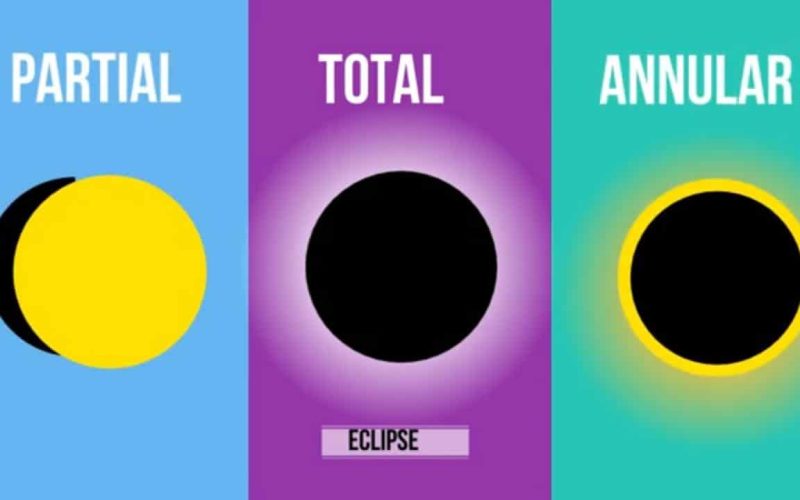Whether the type of eclipse is solar or lunar, an eclipse happens when the moon, the sun, and the earth align partially or completely.
The position of the earth, moon, and sun determines the eclipse types.
Sometimes, in 2017, a solar eclipse occurs when the moon blocks the sunlight.
Eclipse is an ancient Greek word. It comes from the phrase ékleipsis, which means to fail or abandon.
Whether the eclipse is solar or lunar, the term eclipse has fascinated scientists and ordinary people for centuries.
People are starting to understand the concept of the eclipse because many people have always been afraid whenever an eclipse occurs.
In Africa and other parts of the world, many cultures describe the eclipse myths in many ways.
They try to explain what caused the temporary darkening of the sun or the moon.
However, thanks to science, many people can now outgrow the stories they told them and know the real cause of an eclipse, thanks to our scientists and astronomers.
We have two types of eclipse.
1. Solar Eclipse
The solar eclipse is one of the types of eclipse that occur when the moon orbits the earth.
It occurs when the moon moves between the sun and the earth, blocking the sun’s light from reaching the Earth.
This type of eclipse only occurs during the new moon, twice every year, and on an infrequent occasion, five times a year. It can be either a total or partial solar eclipse.
Interestingly, the moon casts two shadows on the Earth during the solar eclipse. The umbra is the first shadow cast.
People standing in the umbra area will see a total eclipse; the second shadow cast is the penumbra. People standing in the penumbra region will see a partial eclipse.
However, unlike the lunar eclipses, a solar eclipse lasts a few minutes.
Furthermore, there are four types of solar eclipses. Total solar eclipse, partial solar eclipse, annual solar eclipse, and hybrid solar eclipse.
- Total Solar Eclipses: This type of solar eclipse occurs when the sun is completely blocked by the moon. Because the size of the moon is considerably smaller, total solar eclipses are only visible from a specific part of the earth. The moon’s shadow will only pass through a narrow path on the earth’s surface. Only the areas around that path will see the eclipse. Furthermore, looking at the solar eclipse without wearing any protective eyewear can cause damage to your eyes. Either you don’t look at the eclipse or the eclipse with a protective eclipse glass.
- Partial Solar Eclipses: A partial solar eclipse occurs when the moon doesn’t completely cover the sun. This eclipse occurs during the build-up of a total solar and annular eclipse. The sun appears to have a dark shadow on a small part of its surface.
- Annular Solar Eclipses: An annular eclipse occurs when the moon doesn’t entirely cover the sun. It occurs when the moon is centered before it, leaving its outer edges to form a “ring of fire.” This happens when the moon is farthest from the earth. An annular eclipse is much rarer than a partial solar eclipse, as it is only visible in a narrow corridor across the earth.
- Hybrid Solar Eclipses: A hybrid solar eclipse combines a total solar eclipse and an annular eclipse. It is very rare.
2. Lunar Eclipse
The lunar eclipse is when the earth’s shadow is cast over the moon. The moon does not have its light; it only shines because its surface reflects the sun’s rays.
A lunar eclipse occurs when the earth comes between the sun and the moon, blocking the sun’s rays from reaching the moon. This type of eclipse is the eclipse of the moon.
A lunar eclipse usually lasts for a few hours. Total lunar eclipses are rare, but partial lunar eclipses can occur at least twice a year.
A lunar eclipse can only be seen from the Earth at night, and there are two types.
The total lunar eclipse and the partial lunar eclipse.
- Total lunar Eclipses: A lunar eclipse occurs when the moon passes through the earth’s umbra shadow, giving the moon that red-orange tone. The reddish color is because the sun’s light passes through the whole earth’s circumference.
- Partial Lunar Eclipses: A partial lunar eclipse occurs when part of the moon enters Earth’s shadow. Rather than the reddish color of a total eclipse, in a partial eclipse, the Earth’s shadow appears very dark on the side of the moon facing the Earth.








